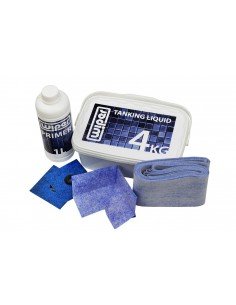- Matt R.
- Shower drains
- 1327 views

We all would like our showers to remain as clean and fresh as before the first bath. Unfortunately, wherever water and detergents are used every day, maintaining perfect cleanliness is difficult and requires some work and new good habits. From the very beginning of having a shower, whether it's a standard shower enclosure or a walk-in shower with a floor drain, it's worth buying a few accessories and getting into the habit of using them regularly. By following these tips, you will significantly extend the look and life of all elements of your shower.
DRAIN CLEANING
Regardless of the type of shower, type of drain or siphon, the problem of hair accumulating in the drain is and will continue to exist. Nobody is going to bathe in a bathing cap, so the only thing left is to clean the siphon regularly. There is only one effective and safe way to do this. Cleaning it by hand. Unfortunately, non-contact methods using caustic agents will not be as effective as regular manual extraction of contaminants. It is best to keep any dissolving agents as the ultimate weapon in the fight against a completely blocked drain. It must be remembered that frequent and incorrect use of aggressive agents can be harmful to the drain, siphon or sewage pipes. Depending on the number of users, usually removing hairs and whatnot mechanically and rinsing the siphon with a strong stream of water should be enough for about two weeks, but in some cases it is worth doing it more often.
SHOWER SQUEEGEE
Another habit worth having is cleaning water from shower screens and tiles after each bath. A water squeegee is a small and inexpensive gadget, thanks to which you will significantly reduce the frequency and intensity of scrubbing your shower. Manufacturers of shower glass are increasingly using water-repellent coatings, which also reduce the amount of water retained on the glass, but this is not an ideal and eternal solution. In addition, you usually do not have such a coating on the tiles. After each shower, rinse off any soap residue from the walls and glass and use a squeegee from top to bottom of both glass screen and tiles. Such a simple procedure will prevent the necessity of subsequent scrubbing of troublesome mineral deposits.
If the cabin you bought was not the cheapest and is to serve you in good condition for years, it is also not worth saving on the squeegee. Avoid products with a narrow and hard rubber on the metal handle, which can scratch the glass and profiles and cause damage to the shower tray if dropped.
REMOVING LIMESCALE
Hard water scale and soap scum are difficult opponents in the fight to keep your shower clean. Getting a good descaling product is crucial. It is important that the agent is safe for the cleaned surfaces. If you want to clean very dirty shower cabin, you will often have to prepare for using the descaling product several times to achieve the desired effect. If the sediment does not come off completely after one spraying, it does not mean that the product is weak. As with a kettle, it takes time for the limescale to dissolve completely. This is the case with shower screens, tiles, shower trays and shower faucets. Covered with multiple layers of limescale and soap, they often won't regain their shine after one quick clean. However, you should remember not to leave the sprayed product on the surfaces to be cleaned for too long, as it may cause discolouration or corrosion in the case of delicate materials. It is always a good idea to test in the least visible place of each cleaned surface first, and only then start the proper spraying and scrubbing.
REMOVING MOULD
Black stains on grout, gaskets or silicone do not necessarily mean that they need to be replaced. The faster you react, the easier it will be to bring them to an aesthetic appearance and safe for health. Chlorine-based agents still work best. As in the case of descalers sometimes a single short use may not be sufficient. Leaving the cleaning product on for several minutes should be enough. The main thing is not to let the spray dry out. With very neglected silicones, the solution may be to soak a paper towel in it, place it on the joint and leave it for several hours. After doing this, you can be sure that the chlorine will kill all spores and whiten the silicone. Of course, as with all such measures, you should be careful and take care of hand protection, adequate ventilation of the room and test the product first. In the case of a closed cabin, it is worth leaving the door open after each bath to prevent the re-growth of mould and bad smell. With open walk-in showers, you don't have to worry about it
Unfortunately, there is no product on the market that would ensure the eternal shine and cleanliness of a daily used shower enclosure. The best recipe for a nice and hygienic shower is still systematic washing and using a squeegee.









